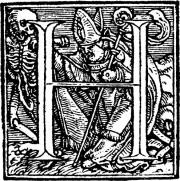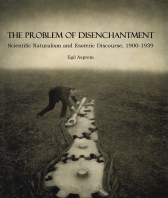I’m only doing one conference this summer season, but that is already turning out to be a massively busy and exciting event. Now that the final program is available, and the book of abstracts can be downloaded, the ESSWE4 conference in Gothenburg, Sweden, stands out as everything that an international conference of the European Society for the Study of Western Esotericism should be: strongly interdisciplinary (the inclusion of historians of science and medicine is particularly noticeable, and a greater number of sociologists and anthropologists is also a highly welcome development), with a rich and varied program that includes panel sessions, discussion groups, roundtables, and keynotes. There is also a dinner in the Masonic Hall and a final esoteric concert event: Genesis P-Orridge and Carl Abrahamsson (known in the esoteric world as editor of The Fenris Wolf) perform live with their act, White Stains. P-Orridge and Abrahamsson will even appear in a half-hour discussion group at the conference itself on the final day, entitled “Music and Esotericism from the Inside Out”.
Browse the program on the website to find out more.
In addition to that, you should check what people are saying about the event in social media on this Tagboard (join the conversation with the tag #ESSWE4). This promises to be the first ESSWE conference with live twitter feeds to follow, so do check that out and contribute if you are going! (I hear there will be free wifi available, so no need to worry about insane roaming charges) .

The always fabulous Genesis P-Orridge flashing hir favourite icon (?). Maybe we’ll find out at the closing event of ESSWE4.
As a board member of the ESSWE, and more particularly as its membership secretary, one thing I find interesting this year is the introduction of a roundtable session with the local groups and thematic networks of the Society. These groups and networks have increased in number over the past few years, and I think it is a great opportunity to bring these together and hear what they are all up to. The regional groups are the Scandinavian Network (SNASWE), the Israeli Network (INASWE), and the South-American CEEO-UNASUR (independent, but affiliated with ESSWE). For the thematic networks, these are currently the Contemporary Esotericism Research Network (ContERN) and the Network for the Study of Esotericism in Antiquity (NSEA). It’s safe to say that more will emerge, and this meeting may indeed stimulate such new initiatives.
Then, of course, a great thing about these conferences is that so many fine people working in this field are brought together for a week’s time of academic discourse, casual talk, drinks, food, friendship and fun.
There may even be a few interesting paper sessions to go to. I’ve just finished my own paper for this year’s conference, which will be an exploration of a rather more contemporary theme than what I covered in my dissertation – but one that has more than enough continuation for those who care to ask me about it: Transhumanism.
Without giving away any spoilers for the actual paper I ended up writing (as contrasted with the imaginal one for which I submitted an abstract last winter), below follows a slightly cropped version of the original abstract:
The Magus of Silicon Valley: Ray Kurzweil’s Transhumanism as Contemporary Esoteric Discourse
In 2004, the editors of Foreign Policy asked a handful of public intellectuals what they considered to be the most dangerous idea floating around in contemporary society. In contrast to the post-9/11 usual suspects, the political scientist Francis Fukuyama pointed to a nascent ideology and social movement thriving at the heart of the booming US tech-industry: Transhumanism. While promising to save humanity from its biological constraints, including the final abolition of diseases and even death itself, Fukuyama saw transhumanism as a threat to the humanistic values of modern liberal democracy. Granting individuals supreme intelligence, superhuman strength, and eternal life through genetic engineering, smart drugs, artificial intelligence, and nanorobotics poses a challenge to the “sanctity of human life” and threatens to impose new forms of inequality and authoritarian elitism, Fukuyama warned.
While transhumanism’s characteristic mix of science fiction and extreme technophilia makes it appear like a distinctly 21st-century form of hubris, this paper shall argue that it responds to problems that have been inherent to Western intellectual history for centuries. Transhumanism addresses questions about the limitations of human nature, the ultimate reach of humanity’s capacity for knowledge and action, and comes out arguing for a radical embrace of self-improvement. Looking beyond the specific means through which such self-improvement is to be achieved, we perceive an ideology displaying strong structural similarities with esoteric thought. We identify an “alchemical” ideal of transformation, a “gnostic” striving for higher knowledge, and an element of “apotheosis”. Moreover, transhumanist discourse contains a fervent eschatological dimension, associated with the advent of the technological “Singularity” – a point in the near future when the technologies of artificial intelligence, nanorobotics, and genetics, thought to progress in an unstoppable exponential fashion, will converge to create a godlike intelligence. The Singularity ushers in the God at the End of History, setting in motion a development that culminates with super-intelligent nanorobots interpenetrating all the matter of the universe, transmuting it to one, connected, conscious cosmos.
This paper explores the esoteric dimensions of transhumanism by focusing on one of its main ideologues, the American engineer Ray Kurzweil (b. 1948), who, besides being the main prophet of Singularity in the form outlined above (dating the event to 2045) and a life-long seeker of physical immortality and technologies for the resurrection of the dead, was recently made director of engineering at Google Inc.
Since I drafted this outline, I’ve become aware of some other significant developments in the transhumanist movement over the past two years. This has led me to make a couple of predictions of my own. But those will be saved for Gothenburg.
![]()
This blog post by Egil Asprem was first published on Heterodoxology. It is licensed under a Creative Commons Attribution-ShareAlike 3.0 Unported License.







[…] and religion proves a popular topic. I started exploring some aspects of the transhumanist movement from the perspective of a scholar of religion and […]
[…] of Leipzig. I’ve written about Dylan’s work previously, and of course, there’s been mention of the ESSWE Network for the Study of Esotericism in Antiquity (NSEA) which he co-founded with […]